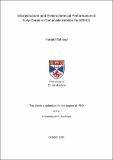Files in this item
Microstructure and electrochemical performance of fully ceramic composite anodes for SOFCs
Item metadata
| dc.contributor.advisor | Irvine, John T. S. | |
| dc.contributor.author | Schlegl, Harald | |
| dc.coverage.spatial | 212 | en_US |
| dc.date.accessioned | 2015-03-26T15:38:20Z | |
| dc.date.available | 2015-03-26T15:38:20Z | |
| dc.date.issued | 2015-06-24 | |
| dc.identifier | uk.bl.ethos.640845 | |
| dc.identifier.uri | https://hdl.handle.net/10023/6361 | |
| dc.description.abstract | Solid Oxide Fuel Cells could play a key role in energy systems of the future because they can directly convert the chemical energy of fuels into electrical energy in a reliable and energy efficient way. The choice of materials for the components of fuel cells is crucial for the achievement of the high performance and the low price necessary to establish fuel cell technology in the energy market. Current state of the art anodes consisting of nickel and yttria stabilised zirconia (Ni/YSZ) offer good electrochemical performance but suffer from limitations like carbon deposition, redox instability and sulphur poisoning. This thesis explores the properties of composite fully ceramic anodes consisting of a skeleton of yttria stabilised zirconia (YSZ) or cerium gadolinium oxide (CGO) and a perovskite phase based on B-site doped lanthanum strontium titanate. The perovskite phase was fabricated in situ inside the pores of the skeleton material by the infiltration of an aqueous precursor and subsequent firing (impregnation method). Material characterisation of the composite anodes was carried out by X-ray diffraction and the microstructure investigated by electron microscope techniques. The electrochemical performance was tested by IV-curves and impedance spectroscopy. Particularly the investigation of the connection between the microstructure of the impregnated anodes and their electrochemical performance is a main objective of this work. The electrochemical performance of cells with a CGO skeleton and an impregnated lanthanum strontium titanate phase was found to be inferior compared to cells with a YSZ skeleton, even if the ionic conductivity of CGO is known to be higher than the ionic conductivity of YSZ. The difference was assigned to mass transport problems tightly connected to the different microstructure of the composite anodes. A significant improvement of the performance could be achieved by the utilisation of A-site deficient perovskites as impregnated phase in a YSZ skeleton. Cells with composite anodes of YSZ and La₀.₄Sr₀.₄Ti₀.₉₄Mn₀.₀₆O[sub](3-δ) show power densities of 156.2 mW/cm² at a measuring temperature of 750 °C compared to 58.5 mW/cm² measured in a similar cell with A-site stoichiometric LSTM, both cells having an electrolyte thickness of around 60 μm. The superiority of the performance of anodes with A-site deficient perovskites is mainly due to a lower ohmic resistance of only 0.5 Ω*cm², indicating better conductivity of the composite with A-site deficient perovskites. The investigation of the microstructure of composite anodes with A-site deficient perovskites showed the decoration of the surface with nanoparticles after reduction. These nanoparticles originate from exsolution of ions from the B-site of the perovskite and can’t be found in A-site stoichiometric perovskites. The influence of fabrication parameters like firing temperature of the skeleton, firing temperature after impregnation or vacuum impregnation on the microstructure and electrochemical performance of the composite anodes was studied. Particularly the increase of the firing temperature of the skeleton from 1400 °C to 1500 °C resulted in an impressive improvement of total cell resistance and maximal power density. | en_US |
| dc.language.iso | en | en_US |
| dc.publisher | University of St Andrews | |
| dc.rights | Creative Commons Attribution-NonCommercial-NoDerivatives 4.0 International | |
| dc.rights.uri | http://creativecommons.org/licenses/by-nc-nd/4.0/ | |
| dc.subject | SOFC | en_US |
| dc.subject | Composite anodes | en_US |
| dc.subject | Impregnation method | en_US |
| dc.subject | Microstructure | en_US |
| dc.subject | Electrochemical performance | en_US |
| dc.subject | Perovskite oxides | en_US |
| dc.subject | SEM | en_US |
| dc.subject | Impedance spectroscopy | en_US |
| dc.subject.lcc | TK2933.S65S3 | en_US |
| dc.subject.lcsh | Solid oxide fuel cells | en_US |
| dc.subject.lcsh | Anodes--Materials | en_US |
| dc.subject.lcsh | Transition metal oxides--Microstructure | en_US |
| dc.subject.lcsh | Scanning electron microscopy | en_US |
| dc.subject.lcsh | Impedance spectroscopy | en_US |
| dc.title | Microstructure and electrochemical performance of fully ceramic composite anodes for SOFCs | en_US |
| dc.type | Thesis | en_US |
| dc.contributor.sponsor | Engineering and Physical Sciences Research Council (EPSRC) | en_US |
| dc.type.qualificationlevel | Doctoral | en_US |
| dc.type.qualificationname | PhD Doctor of Philosophy | en_US |
| dc.publisher.institution | The University of St Andrews | en_US |
This item appears in the following Collection(s)
Except where otherwise noted within the work, this item's licence for re-use is described as Creative Commons Attribution-NonCommercial-NoDerivatives 4.0 International
Items in the St Andrews Research Repository are protected by copyright, with all rights reserved, unless otherwise indicated.


